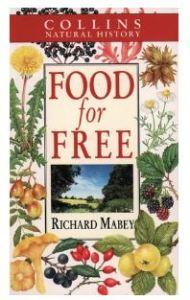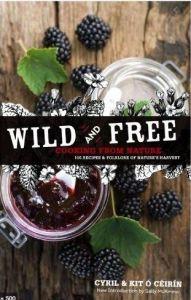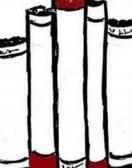Before we go any further I would just like to say that it’s a moot point whether these books a) really count as Landing Tales reads as they don’t live in that shelf region and b) would really be a better fit into our retired craft and garden blog Curiously Creatively. I say moot point, because whatever the arguments either way, these foraging books are what I have decided to feature in today’s blog post. And anyway, as you all already know, I can be somewhat flexible as to what constitutes a bona fide Landing Book Shelves title. As to the subject matter, I refer you to the Landing Excursions category and to the occasional garden or cookery feature that creeps in here. So that’s that out of the way then…

Food for Free by Richard Mabey, published by Harper Collins 1978, 1992
" aria-describedby="caption-attachment-4546" data-orig-size="198,313" sizes="(max-width: 190px) 100vw, 190px" data-image-title="Food for Free" data-orig-file="https://talesfromthelandingbookshelves.files.wordpress.com/2020/06/food-for-free.jpg" data-image-meta="{"aperture":"0","credit":"chris mills","camera":"","caption":"","created_timestamp":"1587474929","copyright":"","focal_length":"0","iso":"0","shutter_speed":"0","title":"","orientation":"0"}" width="190" data-medium-file="https://talesfromthelandingbookshelves.files.wordpress.com/2020/06/food-for-free.jpg?w=190" data-permalink="https://talesfromthelandingbookshelves.com/2020/06/12/two-wild-food-books-food-for-free-and-wild-and-free/food-for-free/" alt="Front over of the 1992 edition of Food for Free showing a variety of plants." height="300" srcset="https://talesfromthelandingbookshelves.files.wordpress.com/2020/06/food-for-free.jpg?w=190&h;=300 190w, https://talesfromthelandingbookshelves.files.wordpress.com/2020/06/food-for-free.jpg?w=95&h;=150 95w, https://talesfromthelandingbookshelves.files.wordpress.com/2020/06/food-for-free.jpg 198w" class="size-medium wp-image-4546" data-large-file="https://talesfromthelandingbookshelves.files.wordpress.com/2020/06/food-for-free.jpg?w=198" />Food for Free, 1992
Food for Free by Richard Mabey (Harper Collins 1972, 1992) was given to me about a year ago and is a former library book, so it had already performed much service by the time it passed into my hands. I think there has been a more recent reprint, which I may try to buy. Wild and Free by Cyril and Kit Ó Céirín, (O’Brien Press 1978; Wolf Hill Publishing 2013) actually belongs to The Bookworm, though I confess that I have rather commandeered it lately. This is what happens when you buy people books that you really want for yourself! Both books were originally published around the same period, looking at British and Irish wild food respectively. There is of course much overlap between the two books as far as flora and the uses to which they were/are put. Each book has its own approach, Food for Free being more of a field or gatherers guide to edible plants. It gives notes on habitat, season and details on how many of the plants have been used in the past, sometimes with basic cooking instructions. For some plants, the text merely notes that the plant is edible (eg the White and Red varieties of Dead-Nettle) without any further detail. In contrast, Wild and Free presents a collection of methods for a range of dishes, cordials, wines, jellies etc based on a seasonal foraging calendar and tried and tested family recipes. The Ó Céiríns write in detail of about twenty-four sources of food, giving plenty of instructions for making such tasty items as elderberry syrup, nettle soup, crab apple wine and a whole host of blackberry treats. There also seems to be a lot of beer and wine recipes!
As the Bookworm and I have a penchant for foraging, they are both handy books to dip into now and again as we like to extend our foraged food range now and again. Up until this year, I’d say that we have arrived at a fairly regular pattern of free range goods, focussing mainly on berries. Usually we end up with a good supply of blackberries, haws, rosehips, rowan berries and elderberries in the freezer for jelly making. We have used various recipes for preserves, but most frequently the Thane Prince book mentioned over on Curiously Creatively. The exception to all of the berry harvest is elderflowers, which we have picked for a lovely refreshing cordial in the last few summers (one batch already made so far this year, we hope to do another). Wild and Free gives a recipe for Elderflower pancakes that I would like to try for a change – I imagine they’d be great for a weekend breakfast.

Wild and Free: Cooking from Nature by Cyril & Kit Ó Céirín 2013.
" aria-describedby="caption-attachment-4545" data-orig-size="311,488" sizes="(max-width: 191px) 100vw, 191px" data-image-title="Wild and Free" data-orig-file="https://talesfromthelandingbookshelves.files.wordpress.com/2020/06/wild-free.jpg" data-image-meta="{"aperture":"0","credit":"chris mills","camera":"","caption":"","created_timestamp":"1591992912","copyright":"","focal_length":"0","iso":"0","shutter_speed":"0","title":"","orientation":"0"}" width="191" data-medium-file="https://talesfromthelandingbookshelves.files.wordpress.com/2020/06/wild-free.jpg?w=191" data-permalink="https://talesfromthelandingbookshelves.com/2020/06/12/two-wild-food-books-food-for-free-and-wild-and-free/wild-free/" alt="Cover of Wild and Free showing blackberry jam & fresh berries." height="300" srcset="https://talesfromthelandingbookshelves.files.wordpress.com/2020/06/wild-free.jpg?w=191&h;=300 191w, https://talesfromthelandingbookshelves.files.wordpress.com/2020/06/wild-free.jpg?w=96&h;=150 96w, https://talesfromthelandingbookshelves.files.wordpress.com/2020/06/wild-free.jpg 311w" class="size-medium wp-image-4545" data-large-file="https://talesfromthelandingbookshelves.files.wordpress.com/2020/06/wild-free.jpg?w=311" />Wild and Free, 2013
But in this particularly strange spring and summer, with the help of our two foraging guides, we have branched out slightly and explored some new foraged food. For quite a while we have been thinking of turning towards having a go at collecting some young ‘greens’ from the wild plants on offer to see if we could make a meal out of wild vegetables. As Richard Mabey points out, ‘It is easy to forget, as one stands before the modern supermarket shelf, that every single one of the world’s vegetable foods was once a wild plant’. This is obvious if you think about it, though as The Bookworm pointed out, you can quite see why nobody ever thought that cultivating and selling nettles was a great idea. Though maybe, a cultivated nettle would have no sting?
As you might have guessed, nettles were one of our target greens, having been meaning to make nettle soup for years. Funnily enough, we were rather wary about the idea of picking something so stingy to eat! Tip: stout gloves are required. It is also worth poiting out that venturing near a nettle patch with ripped jeans means that you get your knees stung at the very least. In the end, our foraging and cooking went very well thanks to the handy recipe in the Ó Céirín book. In the chapter on nettles, the authors retell a story about St Columcille and his Lenten instructions that his soup of nettles, water and salt should have nothing else ‘except what comes out of the pot stick’. The enterprising cook apparently hollowed out the pot stick and poured milk and oats into the broth. A much more substantial meal. Inspired by a note in Mabey’s book, we have also tried Goosegrass or Sticky Weed, which he tells us was recommended in spring soups and puddings by the diarist John Evelyn (1620-1706). We did ours in a pasta dish, which seems to be a much more twenty-first century twist on things.
Moving on to something that we still haven’t tried yet, I was tentatively considering looking for mushrooms and fungus. Mabey’s book has a section on fungus, which I found fascinating reading. I would love to try foraging for edible fungus, but I am aware that I need to do much more research first. At some point I hope to attend a workshop as a starting point, though I’m not sure if I will ever feel confident enough to try it for myself. In the meantime, I am happy to try to merely spot a few examples. The authors of Wild and Free describe a lovely foraging session, when they once gathered bags full of field mushrooms on a walk, which sounded fantastic. Sadly, we don’t live within easy reach of green fields, despite our lifting of distance restrictions now. That’s one for the future. Meanwhile, I will settle for our usual delicious berry harvesting.
I would love to hear from anyone who forages or who has any good book recommendations to pass on to us.

